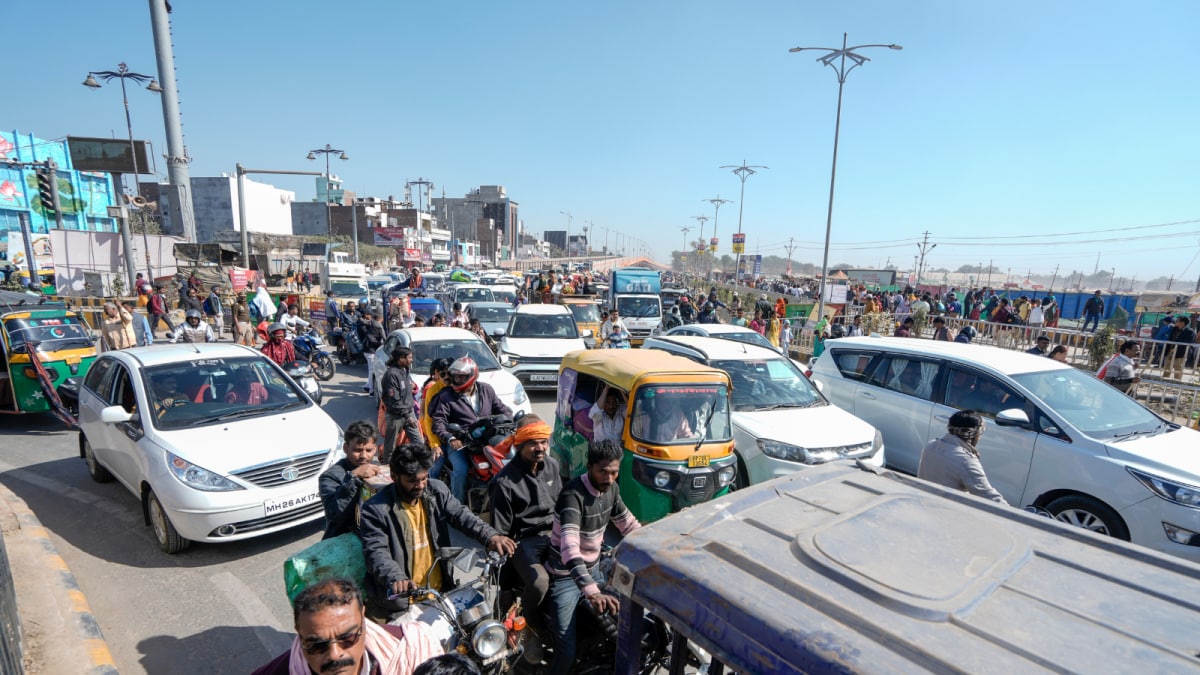 |
|
The Maha Kumbh Mela in Prayagraj, Uttar Pradesh, India, has seen a massive influx of pilgrims, causing significant traffic congestion in recent days. The sheer number of devotees attending the religious festival, estimated to be over 45 crore, overwhelmed the existing infrastructure, leading to travel times that were significantly longer than usual. Journeys that typically take eight hours by road were reported to take as much as sixteen to twenty-four hours, leaving many pilgrims stranded in their vehicles for extended periods. This situation was further exacerbated by the large crowds gathered for Magh Purnima, which added to the already immense pressure on the transportation network. The difficulty wasn't limited to the roads leading into Prayagraj; once pilgrims arrived, they often faced a challenging walk of 10 to 20 kilometers to reach their final destinations, highlighting the scale of the logistical challenges involved.
In response to these difficulties, the Uttar Pradesh Police implemented a comprehensive traffic management plan. Real-time monitoring of all routes leading to the Kumbh Mela was implemented, using a central control room and technological advancements. This allowed the police to dynamically respond to changing traffic patterns, identify potential bottlenecks, and re-route traffic as needed. The use of technology, including live video feeds shared via a WhatsApp group, ensured that all aspects of traffic management were closely observed and acted upon quickly. This coordinated effort by the police was successful in alleviating many of the previous congestion issues, opening up routes previously severely impacted by the influx of pilgrims. Despite warnings issued 200 kilometers away in Madhya Pradesh advising against travel due to overcrowding, the determination of pilgrims to attend the Kumbh Mela remained unwavering.
The article highlights several key routes that are now open and free-flowing. For those traveling from Kashi (Varanasi), a route via Hanumanganj, Andwa, and Jhunsi is recommended, with Google Maps currently indicating it as traffic-free. Similarly, the route from Jaunpur to Prayagraj via Damruwa, Machhli Shahar, Kuvarpur, Mugra Badshahpur, and Jhunsi is now clear, allowing for a significantly reduced travel time of approximately three hours. For pilgrims originating from Rewa, a route through Mangawa, Tikuri, Ghuma, and Kidganj offers a fast journey of around two hours and forty-eight minutes. Individuals traveling from Lucknow are advised to use the Purvanchal Expressway and NH731 route, known for its efficient traffic flow and an estimated travel time of five hours. The city of Prayagraj itself has also seen significant improvements in traffic flow, with key junctions like Balsan Chauraha and Sahason Chauraha now operating without significant congestion.
The success of the traffic management initiatives relies heavily on the collaborative efforts of various stakeholders, including the police force, technological infrastructure, and effective communication between officials. The real-time monitoring and rapid response to traffic issues demonstrate the importance of proactive planning and adaptive strategies in managing large-scale events. The use of readily available technological tools such as Google Maps and WhatsApp groups to share information in real time has shown a significant impact on reducing confusion and travel delays for pilgrims. Further, the provision of designated parking areas, and the deployment of police personnel throughout the city to manage parking and direct pedestrian flow are critical components of this successful model.
The overall situation reflects a positive turn of events. While the initial influx of pilgrims presented significant challenges, the proactive measures taken by the Uttar Pradesh Police and the effective use of technology resulted in a substantial improvement in traffic flow. The provision of alternative routes and the ongoing monitoring of traffic patterns are testament to the commitment to ensuring a smoother and more manageable pilgrimage experience for the remaining duration of the Maha Kumbh Mela. The success of this operation serves as a case study for future large-scale event management, emphasizing the crucial role of technology and coordinated efforts in mitigating traffic challenges and providing a more comfortable experience for attendees.
Source: Heading To Maha Kumbh? Take These Routes To Avoid Traffic Jams
